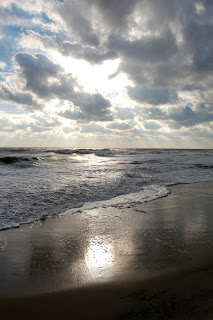 Every seven-and-a-half seconds at night the light at Hatteras still flashes. All electronic now, this process was done in earlier days by hand, and the guardian would haul two five-gallon jugs of kerosene a few times a day up the 268 steps to keep the thing fueled. This was not an easy job, but I wager it was easier than the chore of the men who guarded the coast and saved the drowning. Photos of some of these adrenaline junkies can be seen in the adjoining museum. My dad looked at them, gruffed, and said "These are the sort of people you do not want to get into a fight with." They'd launch out into the surf, often at night, in boats I wouldn't take across a river and would feverishly row out to whatever distressed ship caught their attention. The working relationship between these men and the lighthouses saved innumerable lives, but people still slip beneath the waves along this coast, dubbed the "Graveyard of the Atlantic."
Every seven-and-a-half seconds at night the light at Hatteras still flashes. All electronic now, this process was done in earlier days by hand, and the guardian would haul two five-gallon jugs of kerosene a few times a day up the 268 steps to keep the thing fueled. This was not an easy job, but I wager it was easier than the chore of the men who guarded the coast and saved the drowning. Photos of some of these adrenaline junkies can be seen in the adjoining museum. My dad looked at them, gruffed, and said "These are the sort of people you do not want to get into a fight with." They'd launch out into the surf, often at night, in boats I wouldn't take across a river and would feverishly row out to whatever distressed ship caught their attention. The working relationship between these men and the lighthouses saved innumerable lives, but people still slip beneath the waves along this coast, dubbed the "Graveyard of the Atlantic."I stood on a bank in the ocean, maybe a hundred yards from shore and thought of Walt Whitman. "The boundless vista and the horizon far and dim are all here, / And this is ocean's poem." The waves relentlessly pounded against my back and sides. I turned my back then to the beach and faced the waves head-on. Whitman was from an era in which the sea was much on the minds of people: it carried to them things of other lands and provided food for the table. This is, of course, still very much the case but I doubt we think of it with the poetic intensity of that Civil War nurse. I felt the wet sand slipping between my toes and the arches of my feet, the foam encircling my waist and said aloud, "This is no excuse!"
 What is no excuse is the ambivalence we have towards things out of our immediate purview. Annie Dillard somewhere remarked that we teach children as we were taught: to look alive. Driving to my apartment tonight in an ambush of rain I asked a friend on the phone what this might mean, to be taught to look alive. It was settled that it means we don't teach the young to be alive, but merely to look alive. Flip through the latest celebrity magazine; listen to tawdry local news, blasted as if the stability of the earth's axis depends on its exclamation; busy oneself with inane tasks to avoid any provocative reflection; be convinced of one's own magnitude.
What is no excuse is the ambivalence we have towards things out of our immediate purview. Annie Dillard somewhere remarked that we teach children as we were taught: to look alive. Driving to my apartment tonight in an ambush of rain I asked a friend on the phone what this might mean, to be taught to look alive. It was settled that it means we don't teach the young to be alive, but merely to look alive. Flip through the latest celebrity magazine; listen to tawdry local news, blasted as if the stability of the earth's axis depends on its exclamation; busy oneself with inane tasks to avoid any provocative reflection; be convinced of one's own magnitude.The sea is not so forgiving. It is not enough to look the part of awareness and stand in its waters. Any wave of substance will immediately and without apology pummel the ambivalent. The sea is still wild. There are no sidewalks, no strip malls, no air-conditioned retreats. While those of one age warn with light, some men of another used it to allure and the ships rolled on or crashed as the waves and winds demanded. The sea makes one demand only: to be alive. And not a few "lost souls" would certainly say not even this is enough.
At this late hour it's Emliy Dickinson's dying words that haunt. "Let us go in; the fog is rising."
No comments:
Post a Comment